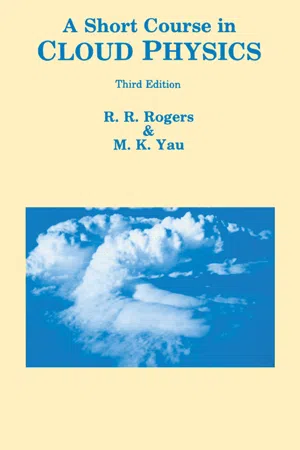
- 304 pages
- English
- ePUB (mobile friendly)
- Available on iOS & Android
eBook - ePub
A Short Course in Cloud Physics
About this book
Covers essential parts of cloud and precipitation physics and has been extensively rewritten with over 60 new illustrations and many new and up to date references. Many current topics are covered such as mesoscale meteorology, radar cloud studies and numerical cloud modelling, and topics from the second edition, such as severe storms, precipitation processes and large scale aspects of cloud physics, have been revised. Problems are included as examples and to supplement the text.
Frequently asked questions
Yes, you can cancel anytime from the Subscription tab in your account settings on the Perlego website. Your subscription will stay active until the end of your current billing period. Learn how to cancel your subscription.
At the moment all of our mobile-responsive ePub books are available to download via the app. Most of our PDFs are also available to download and we're working on making the final remaining ones downloadable now. Learn more here.
Perlego offers two plans: Essential and Complete
- Essential is ideal for learners and professionals who enjoy exploring a wide range of subjects. Access the Essential Library with 800,000+ trusted titles and best-sellers across business, personal growth, and the humanities. Includes unlimited reading time and Standard Read Aloud voice.
- Complete: Perfect for advanced learners and researchers needing full, unrestricted access. Unlock 1.4M+ books across hundreds of subjects, including academic and specialized titles. The Complete Plan also includes advanced features like Premium Read Aloud and Research Assistant.
We are an online textbook subscription service, where you can get access to an entire online library for less than the price of a single book per month. With over 1 million books across 1000+ topics, we’ve got you covered! Learn more here.
Look out for the read-aloud symbol on your next book to see if you can listen to it. The read-aloud tool reads text aloud for you, highlighting the text as it is being read. You can pause it, speed it up and slow it down. Learn more here.
Yes! You can use the Perlego app on both iOS or Android devices to read anytime, anywhere — even offline. Perfect for commutes or when you’re on the go.
Please note we cannot support devices running on iOS 13 and Android 7 or earlier. Learn more about using the app.
Please note we cannot support devices running on iOS 13 and Android 7 or earlier. Learn more about using the app.
Yes, you can access A Short Course in Cloud Physics by M.K. Yau,R R Rogers in PDF and/or ePUB format, as well as other popular books in Physical Sciences & Meteorology & Climatology. We have over one million books available in our catalogue for you to explore.
Information
1
Thermodynamics of Dry Air
Atmospheric composition
Air is a mixture of several so-called permanent gases, a group of gases with variable concentrations, and different solid and liquid particles of variable concentrations. Nitrogen and oxygen account respectively for about 78% and 21% by volume of the atmosphere’s permanent gases, with the remaining 1% consisting mainly of argon, but with trace amounts of neon, helium, and other gases. The composition of air is remarkably uniform, with the relative proportions of these permanent gases being essentially the same the world over and up to an altitude of 90 km.
The most abundant of the gases present in variable amounts are water vapor, carbon dioxide, and ozone. These gases strongly affect radiative transfer in the atmosphere. Water vapor is also of central importance in atmospheric thermodynamics.
The particles of solid and liquid material suspended in the air are called aerosols. Common examples are smoke, dust, and pollen. The water droplets and ice crystals of which clouds are composed are aerosols too, but they are usually classified with rain and other precipitation forms as hydrometeors, condensed forms of water in the atmosphere. Thermodynamics is concerned with the gases, but a select group of the aerosols called hygroscopic nuclei are crucial for the condensation of water in the atmosphere.
The approach in meteorology is to treat air as a mixture of two ideal gases: “dry air” and water vapor. This mixture is called moist air. The thermodynamic properties of moist air are determined by combining the separate thermodynamic behaviors of dry air and water vapor.
Equation of state for dry air
The equation of state for a perfect gas, or ideal gas law, expresses the relationship a...
Table of contents
- Cover image
- Title page
- Table of Contents
- Inside Front Cover
- Copyright
- Dedication
- Preface
- Introduction
- Chapter 1: Thermodynamics of Dry Air
- Chapter 2: Water Vapor and its Thermodynamic Effects
- Chapter 3: Parcel Buoyancy and Atmospheric Stability
- Chapter 4: Mixing and Convection
- Chapter 5: Observed Properties of Clouds
- Chapter 6: Formation of Cloud Droplets
- Chapter 7: Droplet Growth by Condensation
- Chapter 8: Initiation of Rain in Nonfreezing Clouds
- Chapter 9: Formation and Growth of Ice Crystals
- Chapter 10: Rain and Snow
- Chapter 11: Weather Radar
- Chapter 12: Precipitation Processes
- Chapter 13: Severe Storms and Hail
- Chapter 14: Weather Modification
- Chapter 15: Numerical Cloud Models
- References
- Appendix
- Answers to Selected Problems
- Index